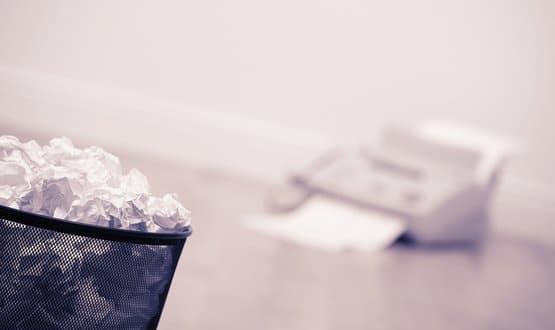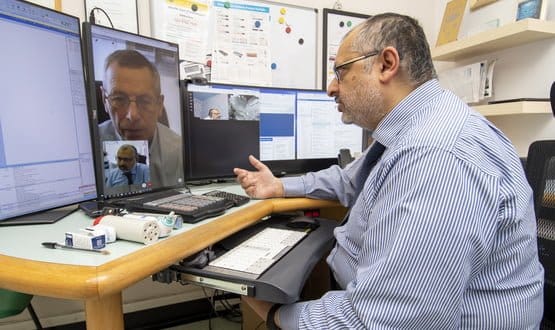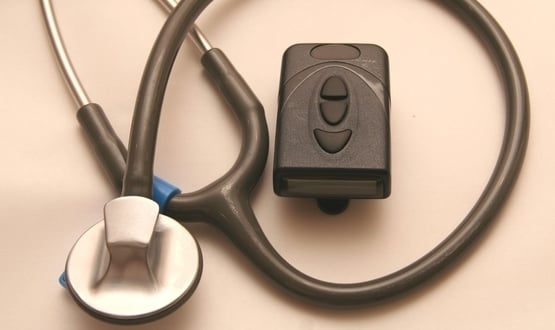Trusts set to miss Axe the Fax deadline due to ‘concerning lack of progress’
- 30 September 2019

A new report looking into the number of fax machines still in use across the NHS in England has shown “a concerning lack of progress” amongst trusts working to remove the them ahead of the April 2020 deadline.
The report reveals that the trusts with the most fax machines have collectively axed just 42% over the past twelve months, with less than six months to go until the ‘axe the fax’ deadline.
The new findings come from a Freedom of Information (FOI) request published by Silver Buck, the marketing and PR agency responsible for running the Axe the Fax campaign.
The FOI also found that trusts that had identified a solution for replacing their fax machines had, on average, removed 9.4% more fax machines than those that hadn’t.
This latest FOI request follows that published by the Royal College of Surgeons (RCS) July 2018, which revealed that the NHS was the world’s largest purchaser of fax machines with nearly 9,000 in use across the healthcare system.
A fresh FOI request was issued to each of the fourteen trusts that responded to RCS FOI request declaring they had 200 or more fax machines.
Three of the fourteen trusts did not respond.
Amongst those that did, two trusts said they had more fax machines in use now than they did when the RCS FOI was issued in July 2018: the Mid Yorkshire Hospitals NHS Trust (one more than reported in July 2018) and the South Tees Hospitals NHS Foundation Trust (two more).
Other trusts, while reducing their number of fax machines, demonstrated a lack of significant progress over the past year. Imperial College Healthcare NHS Trust, for instance, reduced its number of fax machines by less than 16%, from 237 to 200.
Some trusts, however, have shown progress. Most notably, Epsom and St Helier University Hospitals NHS Trust which has reduced its number of fax machines by 99%, from 212 to just 3 (for emergency use only).
Meanwhile, Newcastle upon Tyne NHS Foundation Trust, the trust revealed to have the highest number of fax machines by the RCS FOI report in July last year, has reduced its number of machines by 66%, from 603 to 208.
Bad start
Leeds Teaching Hospitals launched the Axe the Fax campaign soon after the RCS report was published, pledging to remove 95% of its 350 fax machines by 1 January 2019 and ultimately failing to do so.
The latest figures show that progress has been made since then, with the trust having removed 54% of its fax machines.
It is now piloting an eFax service, which enables users to send and receive faxes online and via email.
Support for the Axe the Fax surged in December 2018 when health secretary Matt Hancock banned the NHS from buying more fax machines and ordered a complete phase-out of the technology by 31 March 2020.
Sarah Moorhead, associate director of digital demand at Leeds Teaching Hospitals, said: “Axing the fax has been a real challenge and many issues were found than we first imagined. It’s no secret that we would have wanted to remove even more than we have, but we are encouraged that each machine we remove is of massive benefit to waste reduction and progress towards a digital hospital.
“Our biggest challenge has been getting rid of fax machines that are used to communicate externally. Lots of outside organisations rely on fax machines to communicate with us, and some of them still heavily depend on paper-based solutions where they are yet to start their digital maturity journey.
“eFax has been a really important tool for us, getting over this hurdle, and it’s part of the reason that we’re still confident of meeting Hancock’s deadline.”





22 Comments
The tech versions are relatively simple, so why don’t we have them in the UK? I’ve done an early FHIR version at a couple of NHS trusts/boards.
It appears the requirement or use case isn’t getting to NHS D/X and E?
We cant digitally transform healthcare without collecting the patients email address. Just collect their preferences around communication and most will select email. Its pitiful that we are still having this debate.
The topic isn’t focused on patient communication. You’ll find most patients already communicate by email or phone and email communication shouldn’t ever request any sensitive/personal information, for all the reasons you hear about on a daily basis.
Surely ‘Axing the Fax’ cannot be said to be satisfied by replacing it with an eFax system? The machines are part of the problem, but one of the biggest issues with faxes is that at the other end you have no idea where the machine is or who will be able to read the output. If you use an efax, then the other end is still likely to be an actual machine. And sending an efax to another efax seems silly, you could just send an email!
We have largely got rid of fax machines but we do have issues with some organisations – which include other NHS Trusts, but also benefits agency and the local authority – who are still asking for them. I suspect this is down to individual areas who are not familiar with the high level policies and I am trying to root it out.
Email is not GDPR compliant, is easily manipulated and most importantly, doesn’t meet the demand of the other end user. The simple fact is that a virtual solution for Leeds is more efficient, secure and cost effective but most importantly it’s ensures they can interact with GP’s, Physio’s and everyone else external to the NHS who rely on fax for secure transmission of personal data.
Actually fax is simply a transmission protocol, when the fax machine is eliminated you’re dealing with an electronic document. Having used the technology, it delivers the document to a secure cloud location and then it lets us file it away into patient records without ever printing. Works quite well for us.
I don’t think you can say that a particular channel is not GDPR compliant. It depends on what DS&P processes etc you have around it use. However, its clear that its uses are limited due to the nature of needing to communicate PID electronically. Perhaps someone should seed the industry with a free, standard comms channel that fixes this problem, but is as easy as email/fax from a UX perspective.
That’s interesting… and I suppose it depends a bit on what you mean by ‘efax’. My interpretation of this was that it replaced the machine with an email to fax gateway, which converted the document into the familiar sounds, sent it across a phone line (or equivalent) to either an actual fax machine or another efax service which simulates a fax machine. This is basically what ours does.
If on the other hand it is simply an internet based means of transferring a file securely from a to b, then this sounds fine but is it really any different from a secure email or secure email service like the one nhs.net provides?
@ James, your interpretation is pretty spot on, it’s traditional faxing with a modern, secure enhancement. @ Ian Vincent, you’re using it exactly how it should be used.
@ The Insider, GDPR compliance is based specifically on how the data is controlled. Hacking email at the highest level is all too common whereas hacking fax/phone lines requires significant man power and investment to achieve, therefore it’s significantly more secure.
Perhaps I’m overstating when I say email isn’t compliant, as a channel at least but generally it simply isn’t. The industry may one day offer a new, if not free alternative but that’s a long way off. What matters for all today is convenience, efficiency, security and cost effectiveness.
Sometimes you CAN eat your cake and have it!
@Luke Duffy – you are missing the point a bit about GDPR as security of transmission is only one aspect of GDPR (and the point about security is debatable)
The problem with faxes (apart from the fact they use paper and ink) is that they are usually located in open spaces and so there is no way of guaranteeing that the recipient of the message is the intended recipient. Our fax machine is in a staff only area with security doors but all staff have access as well as escorted visitors, cleaning staff, maintenance staff etc). Once it is printed it has no encryption. At the point of printing you also lose any ability to audit what happens to it. At least with email you can see a clear timeline and we can suck emails straight into our clinical system further enhancing the audit trail.
I think our wires are crossed here Damian. Efax is how you move away from the machine and into your existing technology. Be it a computer, laptop, table or phone.
I’d love to know who these “outside organisations” are that still use fax.
Achoo GPs
As a GP we would love to get rid of our fax machine but our local providers keep sending us faxes!
Don’t blame GPs for this problem. It is everyone’s problem. And as there is a machine (or eFax) at both ends then we need to work together to eliminate it.
I think one of the problems is that the NHS has learnt to use fax for urgent communications – we put machines in prominent places and when they beep we have staff trained to pick it up and action it. Email doesn’t naturally have that functionality and we certainly haven’t learnt to use it that way.
No one is blaming GP’s, you just happen to be placed right in the middle. We sympathize and have a solution for you!
If you have a laptop and/or tablet, which takes up a fraction of the space a fax machine does, you can have both visual and audio notifications ready for your team to react to inbound faxes.
This was you can get rid of your machine, utilize that valuable space you’ve now got and meet the demands of your local providers at the same time!
I agree that works as a solution but that means all 7100 GP practices getting a laptop and setting it up correctly and training staff and then telling everyone who faxes them currently that they need to change to email.
I’m not saying it can’t be done, just that it is not an easy task, has costs associated and needs everyone to get on board.
Hi Damian, I’m delighted you’ve raised these points because I’m sure there are many out there who have similar concerns about how this works.
The efax service is run through an online account or through an APP. You don’t have to install anything or get it setup, it does what it does with ease.
All GP’s have a computer at least, if not a laptop and/or tablet. The service is very easy to use so training takes virtually no time at all.
Switching doesn’t affect the faxing process at all, everyone who deals with GP’s would continue to do what they have always done, that is unless they read this and switch from their fax machine to efax lol
In reality, the switch from a machine to efax is easy, you can keep your number, save on the cost of running/managing your machine and much more. You should take a look and see for yourself.
Community pharmacies often do not have immediate access to NHS.net email. A number of small medication suppliers also still use faxes for orders.
In terms of business continuity, we still use them with other hospitals in the event of significant network failure.
Sorry I think I hit the wrong reply button!
I was referring to replacing the fax rather than going to eFax. I agree eFax may have to be the starting point but as James pointed out it isn’t really what we are looking to do and potentially just prolongs the pain.
It’s all relevant Damian and I appreciate where you’re coming from, it’s rare you’ll find a ‘one-size fits all’ so everyone will figure out what fit’s their needs. Unfortunately there isn’t an escalator to bring everyone where they would ideally like to be (the top) so it’s one step at a time and by all means stay on the step you’re currently on, at least for anyone who’s looking to take a step in a new direction, this is one effective option on the table.
I take your point, but the issue here is that the needs of the end user are secondary to the needs of the patient in terms of having a reasonably secure means of transferring their information. I’m not an expert on GDPR but I don’t see how you can say that email ‘is not GDPR compliant’ because presumably this depends on which email service and how you use it. We use nhs.net every day for confidential information which is fully compliant.
We have eFax but it is really just a means of disguising the problem, and you have the odd situation of turning an image into an analogue signal, sent over digital phone lines, only to be demodulated again.
nhs.net does have the built in [secure] feature which in effect allows you to send stuff safely to normal email accounts. I think it really is time for the NHS to make a stand on this, most other big industries have abandoned faxing years ago. Even solicitors and the courts (usually very slow) have largely moved to an electronic system, and I’m sure we can do the same
You’re more knowledgeable than you believe in fairness. The truth is that all technology will evolve over and over. The NHS internal communication service is spot on for internal communications, but its limited to internal, as you pointed out, which email service and how you use it is an important factor to consider.
Maintaining a GDPR compliant means of communication with pharmacies, GP’s etc. where confidential information is used, is of significant importance to all involved and email simply doesn’t offer that security across the board whereas fax does and is recognized as legally binding.
The end users in this case are vast in number and often essential to the welfare of patients. You see how difficult it’s been for the NHS to roll out this internal program, imagine trying to roll out a similar program to the thousands of external contacts who would incur significant expense to meet appropriate levels of security.
The Legal, Healthcare, Financial and Manufacturing industries are the largest fax users globally. Some within these industries have abandoned this method of communication but most still use it for security and proof of legitimacy.
I’m curious as to what problem you refer to, that eFax is disguising? Surely it simply offers a solution to a need that exists and it is the best/only solution that meets everyone’s situation currently?
Comments are closed.